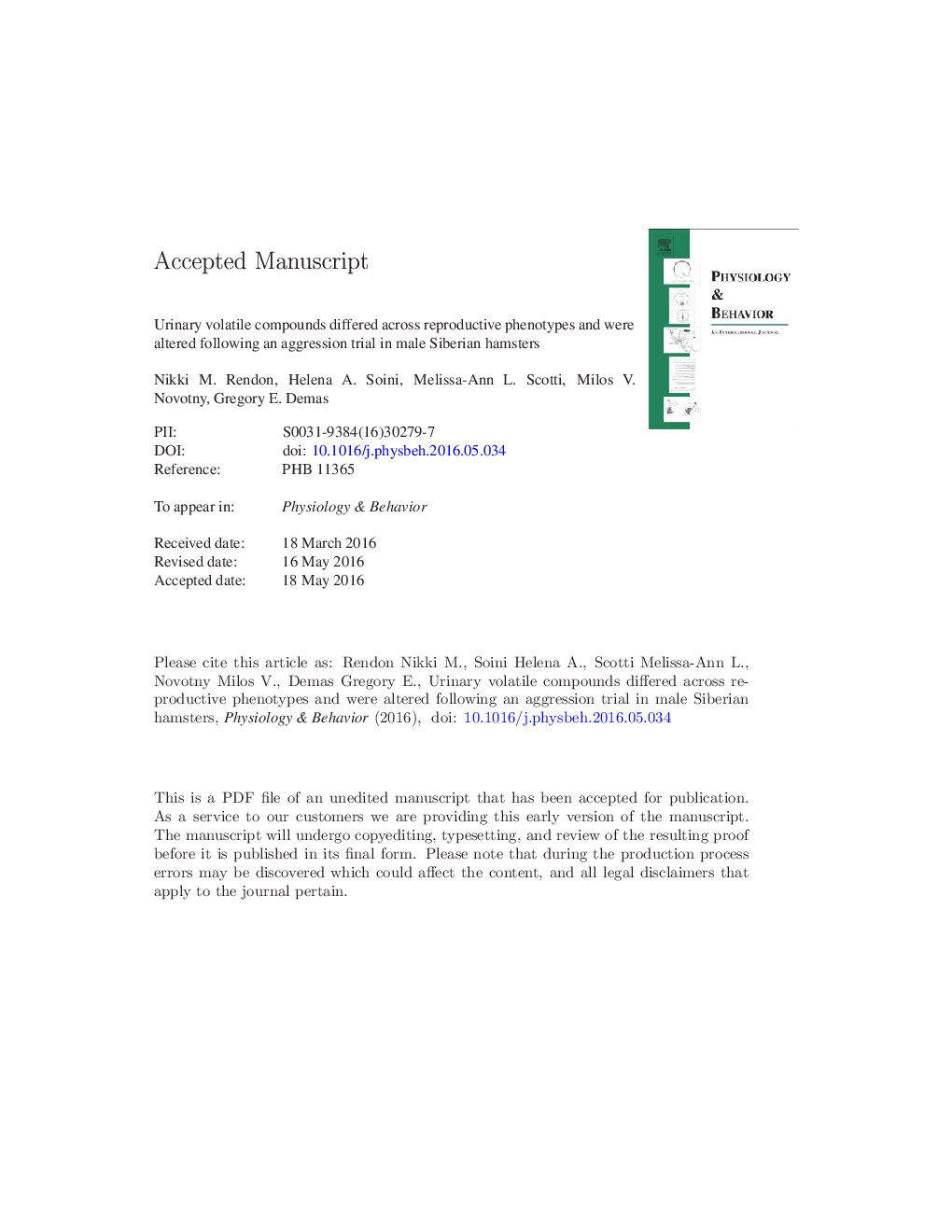| کد مقاله | کد نشریه | سال انتشار | مقاله انگلیسی | نسخه تمام متن |
|---|---|---|---|---|
| 5922588 | 1166279 | 2016 | 36 صفحه PDF | دانلود رایگان |
عنوان انگلیسی مقاله ISI
Urinary volatile compounds differ across reproductive phenotypes and following aggression in male Siberian hamsters
ترجمه فارسی عنوان
ترکیبات فرار ادرار در بین فنوتیپ های تولید مثل و بروز تهاجم در همسترهای سیبری مرد متفاوت است
دانلود مقاله + سفارش ترجمه
دانلود مقاله ISI انگلیسی
رایگان برای ایرانیان
کلمات کلیدی
ترجمه چکیده
ارتباطات شیمیایی با تسهیل برخورد اجتماعی، نقش مهمی در رفتار اجتماعی ایفا می کند و به ارزیابی شرکای اجتماعی، تعریف سرزمین ها و اطلاعات تبلیغاتی مانند گونه و جنس می پردازد. عفونت اطلاعاتی در مورد محیط اجتماعی جوندگان و سایر پستانداران ارائه می دهد؛ با این حال، مطالعات شناسایی ترکیبات شیمیایی و عملکرد آنها تا کنون در درجه اول به چند گونه متمرکز شده است. علاوه بر این، توجه به مراتب کمتر به این موضوع پرداخته شده است که چگونه عوامل محیطی و شرایط رفتاری این ترکیبات را در طی دوره های باروری باروری تغییر می دهند. ما اثرات فتوتریدها و زمینه های اجتماعی را در ارتباطات شیمیایی در هامستر سیبری فصلی نژادی بررسی می کنیم که تجربیات ناگهانی ارضی را در طی طولانی مدت تابستان نشان می دهد روزها، اما افزایش تهاجمی در کوتاه مدت زمستان مانند؟ روزها. نمونه های ادرار را از همسترهای مردانه طولانی و کوتاه مدت جمع آوری کردیم تا بررسی شود که چگونه فتوترئید و تغییرات پس از آن در فنوتیپ های تولید مثل تغییرات پروفایل های ترکیبی ادرار را تغییر می دهند. بعد، ما تغییرات در ترکیبات ادرار را قبل و بعد از برخورد مهاجم شناسایی کردیم. همسترهای مزرعه در طی دوره های نورانی نمایه های مختلف ادراری را نشان می دادند؛ با این حال، مردان تولید مثل در طول روز، در مقایسه با مردان کوتاهمدت غیر تولید مثل، سطوح بالاتر ترکیبات فردی را نشان دادند. علاوه بر این، ترکیبات فردی پس از برخورد مهاجم تغییر یافتند؛ بعضی فقط در روزهای طولانی تغییر کردند در حالیکه دیگران بدون در نظر گرفتن نور فوریه تغییر کردند. علاوه بر این، تهاجم و سطح گردش خون تستوسترون با ترکیبات ادراری در مردان طولانی مدت، اما نه کوتاه مدت همبستگی مثبت داشت. این یافته ها نشان می دهد که تنظیم فیزیولوژیکی فوریت های فتوتروئید و فیزیولوژیک ترکیبات ادراری در این گونه را در بر می گیرد و در درک بیشتر ارتباطات شیمیایی به طور گسترده ای کمک می کند.
موضوعات مرتبط
علوم زیستی و بیوفناوری
بیوشیمی، ژنتیک و زیست شناسی مولکولی
فیزیولوژی
چکیده انگلیسی
Chemical communication plays an integral role in social behavior by facilitating social encounters, allowing for the evaluation of social partners, defining territories and advertising information such as species and sex. Odors provide information about the social environment for rodents and other mammals; however, studies identifying chemical compounds and their functions have thus far focused primarily on a few species. In addition, considerably less attention has been focused on how environmental factors and behavioral context alter these compounds during periods of reproductive quiescence. We examined the effects of photoperiod and social context on chemical communication in the seasonally breeding Siberian hamster which displays modest territorial aggression during long “summer-like” days, but increased aggression in short “winter-like” days. We collected urine samples from long- and short-day male hamsters to investigate how photoperiod and subsequent changes in reproductive phenotype alter urinary volatile compound profiles. Next, we identified changes in urinary compounds before and after an aggressive encounter. Male hamsters exhibited a diverse urinary profile across photoperiods; however, long-day reproductive males showed higher levels of individual compounds when compared to short-day non-reproductive males. In addition, individual compounds were altered following an aggressive encounter; some changed only in long days whereas others changed regardless of photoperiod. Further, aggression and circulating levels of testosterone were positively correlated with urinary compounds in long-, but not short-day males. These findings suggest both photoperiod- and aggression-specific physiological regulation of urinary compounds in this species and contribute to a greater understanding of chemical communication more broadly.
ناشر
Database: Elsevier - ScienceDirect (ساینس دایرکت)
Journal: Physiology & Behavior - Volume 164, Part A, 1 October 2016, Pages 58-67
Journal: Physiology & Behavior - Volume 164, Part A, 1 October 2016, Pages 58-67
نویسندگان
Nikki M. Rendon, Helena A. Soini, Melissa-Ann L. Scotti, Milos V. Novotny, Gregory E. Demas,
